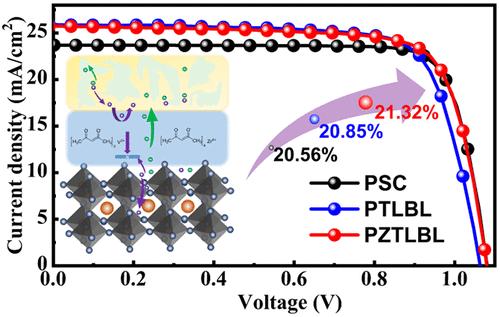Highly Efficient Integrated Perovskite/Organic Bulk-Heterojunction Solar Cells Combining Layer-By-Layer Processing Ternary Systems and Interface Modification
IF 5.4
3区 材料科学
Q2 CHEMISTRY, PHYSICAL
引用次数: 0
Abstract
Integrated perovskite/organic bulk-heterojunction (BHJ) solar cells (IPOSCs) have been developed to extend the photoresponse of perovskites in the near-infrared region. Serious charge recombination at the perovskite/organic BHJ interface always reduces the open-circuit voltage (VOC) and filling factor (FF). Here, we first prepare IPOSCs with layer-by-layer processing ternary BHJ (PTLBL), in which the acceptor mixture consists of Y6 and PC61BM. PC61BM addition inhibited the charge recombination in IPOSCs and induced PTLBL devices with a champion power conversion efficiency (PCE) of 20.85%. Then, we modified the perovskite surface with vanadium acetylacetonate (VAcac) and zirconium acetylacetonate (ZrAcac), which reduced the perovskite surface potential, enhanced the charge transfer between the perovskite and BHJ, and regulated the carrier extraction. The PTLBL devices with VAcac and ZrAcac exhibit champion PCEs of 21.06% and 21.32%, respectively, because of the further improvement in VOC and FF. Combining layer-by-layer processing of ternary BHJ with interfacial materials provides a feasible strategy for simultaneously improving all the parameters of IPOSCs.

结合逐层处理三元系统和界面改性的高效集成 Perovskite/有机块状异质结太阳能电池
为了在近红外区域扩展包晶石的光响应,人们开发出了集成包晶石/有机大块异质结(BHJ)太阳能电池(IPOSC)。在包晶/有机 BHJ 界面上严重的电荷重组总是会降低开路电压(VOC)和填充因子(FF)。在这里,我们首先利用逐层处理三元 BHJ(PTLBL)制备了 IPOSC,其中受体混合物由 Y6 和 PC61BM 组成。PC61BM 的加入抑制了 IPOSC 中的电荷重组,并诱导 PTLBL 器件实现了 20.85% 的冠军功率转换效率 (PCE)。然后,我们用乙酰丙酮钒(VAcac)和乙酰丙酮锆(ZrAcac)修饰了包晶表面,从而降低了包晶表面电位,增强了包晶与 BHJ 之间的电荷转移,并调节了载流子萃取。使用 VAcac 和 ZrAcac 的 PTLBL 器件由于 VOC 和 FF 的进一步改善,PCE 分别达到了 21.06% 和 21.32%。将三元 BHJ 的逐层处理与界面材料相结合,为同时改善 IPOSC 的所有参数提供了一种可行的策略。
本文章由计算机程序翻译,如有差异,请以英文原文为准。
求助全文
约1分钟内获得全文
求助全文
来源期刊

ACS Applied Energy Materials
Materials Science-Materials Chemistry
CiteScore
10.30
自引率
6.20%
发文量
1368
期刊介绍:
ACS Applied Energy Materials is an interdisciplinary journal publishing original research covering all aspects of materials, engineering, chemistry, physics and biology relevant to energy conversion and storage. The journal is devoted to reports of new and original experimental and theoretical research of an applied nature that integrate knowledge in the areas of materials, engineering, physics, bioscience, and chemistry into important energy applications.
 求助内容:
求助内容: 应助结果提醒方式:
应助结果提醒方式:


